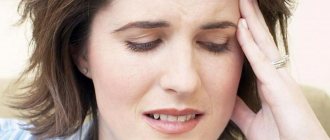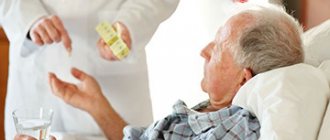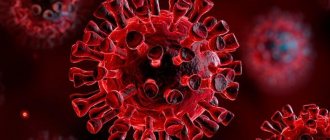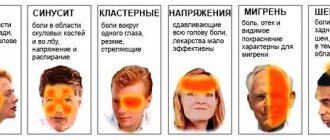There are a number of conditions in which it is impossible to bend over without causing pain in the head. In some cases, this does not pose a danger to the body. People who are weather-sensitive and those who drank alcohol the day before are predisposed to this symptom.
If your head hurts severely when bending down for no obvious reason, or the symptom is accompanied by additional warning signs, you should seek help from a doctor.
The main thing is not to try to cope with the problem yourself by taking medications, this can cause increased cephalgia and the development of complications.
Why does my head hurt when I bend down?
Even a person who is not prone to cephalgia can admit that he gets a headache when he bends over. Sometimes, such an isolated and specific symptom allows one to suspect the presence of a serious pathology. One-time manifestations of the problem are caused by stress or drafts. This also includes reasons such as overwork, a drop in blood pressure due to prolonged stay in a stuffy room.
Various symptoms and syndromes, with an emphasis on headache when bending down or changing body position, are characteristic of the initial stage of colds and viral infections. In any case, it is better to undergo diagnostics and make sure that the pain is not caused by problems with the spine, blood vessels, meninges and substances, or infectious agents.
Sinusitis
Inflammation of the nasopharynx mucosa against the background of a runny nose leads to swelling of the tissues. Due to the mucus blocking the passages, the mass stagnates and microorganisms begin to actively multiply in it. The sinuses gradually fill with pus, which leads to severe headaches. Pulsating sensations are localized in the temples and forehead, intensifying when bending down, staying in a horizontal position, tapping with your fingers on the areas around the nose and between the eyebrows. They are especially pronounced in the morning and after a nap.
If, after suffering from a runny nose or against its background, symptoms of intoxication persist, and when tilting the head down there is a lot of pressure on the head, it is necessary to urgently visit an ENT specialist. Drinking tea with lemon or raspberries will not help here, and heating it without a doctor’s permission can create a dangerous situation. Treatment requires medication. In some cases, it is necessary to make a puncture and drain the cavities from pus.
You will learn about the relationship between sinusitis and cephalalgia here.
Hypertension
Due to a persistent increase in blood pressure, a person may experience pain with any movement. The sensations are pronounced, pulsating or bursting, and when the symptom persists for a long time, it becomes aching. Some patients cannot even close their eyelids to rest due to the pressure on the eyes from the inside.
The clinical picture is complemented by weakness, dizziness, shortness of breath and redness of the face. People with hypertension who have a headache when bending down need diagnosis and specialized treatment. Ignoring the problem can lead to the development of a hypertensive crisis or stroke.
You will learn about the effect of hypertension on pathology from this article.
Migraine
Throbbing pain that is localized in the forehead and extends to the temple or eyes does not necessarily indicate sinus inflammation. A similar clinical picture is observed with migraine. Patients also note fever, irritability from bright lights and loud sounds. Attacks often develop at night, so the pain syndrome reaches its peak in the morning. Before an exacerbation, many people drink large amounts of liquid, which causes a feeling of swelling in the body.
To distinguish migraine from sinusitis, you need to pay attention to the following points:
- in the first case, the cephalalgia is one-sided, and the sensation does not necessarily intensify if you tap on the bridge of the nose or areas around the nose;
- exacerbation of pain inside the head when bending over is typical for both conditions, but in the case of migraine, any movement leads to this;
- sinusitis is usually a consequence of a cold or viral infection, and migraines often develop due to stress or under the influence of one of the triggers;
- a neurological disease is often accompanied by nausea and vomiting, which brings relief.
If you suspect one of the conditions, you should seek help from specialists. The principles of treatment of these pathologies differ radically. Despite the obvious differences in the course of the diseases, only an experienced doctor will be able to make the correct diagnosis and select the optimal treatment options.
You can learn about the symptoms and treatment of migraine with aura here.
Osteochondrosis of the cervical vertebrae
Depending on the severity of the condition, pain can be episodic, chronic or protracted systematic. Due to a decrease in the functionality of the nerves and blood vessels of the cervical spine, the innervation and nutrition of the neck muscles and brain tissue are disrupted. When bending over, patients experience pain in their temples and the back of their heads. The sensations intensify in the afternoon, after physical exertion, or staying in one position for a long time. Head movements are accompanied by a crunching sound, they are stiff and cause discomfort.
You can learn more about cervical osteochondrosis and its impact here.
Allergy
The pain appears suddenly and is localized in a specific part of the skull, and does not spread over the entire area. When you sharply tilt your head down, the sensations reach their peak. The type of cephalgia can be different - from lumbago in the back of the head, crown or frontal area to severe pulsation or distension. The symptom rarely appears in isolation. It is usually accompanied by swelling of the soft tissues of the face, lacrimation, and rhinitis. The usual signs of allergies such as sneezing, itching, redness of the skin or mucous membranes, and rashes may appear. Due to the development of intoxication of the body, taking antihistamines alone may not give the desired result. Treatment requires comprehensive treatment under the supervision of a therapist or allergist.
Tension pain
Painful sensations of a pressing type may appear in the forehead, temples or back of the head, but after some time they cover the entire head like a tight hoop. They arise due to physical or emotional overstrain, against a background of stress or chronic fatigue. The symptom intensifies in the afternoon and subsides after rest, relaxing manipulations, massage or taking sedatives. When bending downward, not only a sharp increase in pain is noted, but also dizziness and mild nausea.
Other reasons
These are just the main factors that provoke the appearance of headaches that arise or intensify when tilting the head. The symptom is characteristic of a number of dangerous conditions that require immediate medical attention. For example, it may indicate the opening of internal bleeding or a stroke.
Processes that may cause headaches when bending over:
- increased intracranial pressure;
- inflammatory processes in the body, regardless of location;
- decreased vascular functionality;
- pathological change in blood composition;
- the beginning of the menstrual cycle, pregnancy, menopause in women;
- intoxication of the body due to food, alcohol or chemical poisoning;
- cancerous or benign brain tumor, polyps in the nasal cavity;
- unhealthy diet – consumption of foods with chemical additives;
- temporal arteritis;
- hypothermia, which led to stiffening of the neck muscles.
Another specific symptom is well known to divers and climbers. Climbing to a height of more than 3 km or immersing several meters under water leads to pressure changes, which affects the functioning of internal organs and the condition of the cavities of the skull. The occurrence of a symptom in some cases may not be a physiological feature, but a consequence of barotrauma.
Source: insultinform.ru
Causes and mechanisms
The origin of headaches is extremely varied. This symptom has several development mechanisms. Painful sensations that occur when bending over are probably associated with the following pathophysiological issues:
- Accumulation of exudate in the paranasal sinuses.
- Increased cerebrospinal fluid pressure in the ventricles of the brain.
- Difficulty in the outflow of blood from the venous sinuses.
- Irritation of the nerve roots of the cervical spine.
- Muscle tension in the head and neck.
Most often we are talking about a local process that provokes headaches. But in some cases you have to think about systemic disorders in the patient’s body. With the involvement of the above mechanisms, the following conditions develop:
- Sinusitis (frontal sinusitis, sinusitis).
- Liqueur hypertension.
- Vegetovascular dystonia.
- Arterial hypertension.
- Pathology of the cervical spine (osteochondrosis, spondyloarthrosis).
Pain when moving the head can also occur with myositis - inflammation of muscle tissue. For some, all they have to do is sit under a running air conditioner, especially after being in the heat, and such a pathology is already guaranteed. For others, factors in the development of headaches include prolonged uncomfortable postures or psycho-emotional stress. It cannot be ruled out that the symptoms may well have a mixed origin, being the result of a combination of several mechanisms in one patient.
The causes of headaches that occur when tilting the head are quite varied. And you can deal with them only after differential diagnosis.
Safe medications and pills
When planning a visit to the doctor, the patient should be prepared to answer questions about how often pain occurs and what its intensity is. This will help the doctor develop the correct treatment tactics.
↑
Groups of drugs effective for episodic attacks of pain
Medicines for the treatment of pathology are non-steroidal anti-inflammatory drugs (NSAIDs). They have an analgesic effect, relieve inflammation, and eliminate swelling.
Often prescribed:
- Ibuprofen-400 mg per day;
- Ketoprofen-100 mg/s;
- Naproxen-500 mg/s;
- Meloxicam-7.5-15 mg/s;
- Celecoxib-200 mg/s.
Most NSAIDs have a negative side effect: with long-term use, they negatively affect the organs of the gastrointestinal tract, including the development of drug-induced gastritis.
Medicines Meloxicam and Celecoxib are new generation drugs that do not have a negative effect on the gastrointestinal tract. The disadvantages of using these drugs include the relatively high price.
Analgesics are often used at home to relieve an attack. They do not treat the disease, but only relieve pain. Drugs in this group are suitable for stopping episodic attacks, but their systematic use leads to the occurrence of abuse syndrome.
During an attack of pain, you can take Paracetamol-100 mg, Citramon, Analgin-500 mg or Mig 200-400 mg.
If the examination revealed the appearance of cephalgia after exercise as a result of increased blood pressure, the doctor will prescribe medications prescribed at an early stage of the development of hypertension. These include: vasodilators, ACE inhibitors, diuretics, calcium channel blockers.
Self-prescribing antihypertensive drugs is unacceptable. Self-medication leads to serious consequences.
For muscle tension, drugs from the group of muscle relaxants are used as part of complex treatment. They relax the spasmodic muscles of the head and neck, relieving pain of a spastic nature, and help restore blood flow.
Often prescribed:
- Mydocalm-150-450 mg per day;
- Sirdalud (Tizanidine) - 4 mg/s;
- Baclofen-15 mg/s.
Nootropic drugs are often prescribed as part of complex treatment: Phenibut, Nootropil, Glycine. Nootropics have an activating effect on brain function and increase its resistance to damaging factors. The drugs improve cerebral circulation and eliminate the consequences of traumatic brain injuries.
Sedatives in combination with basic drugs lead to muscle relaxation and decreased vascular tone. Taking tranquilizers helps relieve pain, but this type of medication quickly causes drug dependence with withdrawal symptoms.
Sedatives that are not addictive: Afobazol, Atarax; alcohol tinctures of valerian, motherwort, Maryina root.
For severe attacks, a combination of drugs is used: Sirdalud 2 mg + Aspirin 500 mg or Analgin 250 mg + sedative.
The use of vitamin B complexes has proven itself. Vitamins B1, B6, B12 have a beneficial effect on the central nervous system and restore the structure of nerve tissue. Vitamin complexes are often prescribed: Neuromultivit, Milgamma, Neurovitan.
If attacks of pain recur more than 10 times a month, a course of treatment with Ibuprofen at a dose of 400 mg per day for 2-3 weeks and treatment with muscle relaxants is prescribed for 2-4 weeks.
There is no single scheme for pain relief. Depending on the cause, each patient needs an individual selection of drugs.
↑
Treatment of chronic disease
Sometimes cephalalgia becomes chronic. The pain occurs every day, continuously, with varying degrees of intensity.
Tricyclic antidepressants are prescribed for a long course of 2-6 months. They relieve pain and help normalize the psycho-vegetative state of the nervous system.
Amitriptyline 10-100 mg/s is most often prescribed, the dose is increased gradually. The drug relieves pain well, but has many negative side effects and is addictive.
As an alternative, selective serotonin reuptake inhibitors are prescribed: Fluoxetine, Paroxetine, Sertraline. The course of treatment is at least 2 months. These drugs have less toxicity.
In addition to prescribing drug therapy, the doctor will recommend massage, a course of physiotherapy or acupuncture.
↑
Symptoms
The first thing a doctor does to determine the source of the disorder is to examine the clinical symptoms. He evaluates subjective signs that concern the patient (complaints) and conducts an examination, and, if necessary, uses other physical methods (palpation, percussion and auscultation). This is how it is possible to obtain most of the information about the pathology.
If your head hurts when you bend over, then you need to understand what pathological mechanism is involved. The task is greatly facilitated by assessing the characteristics of the symptom. Pain characteristics may vary:
- Type: dull (bursting, aching, pulling) or sharp (shooting, burning, pulsating).
- Localization: in the frontal, zygomatic, parietal, temporal or occipital parts, encircling (like a helmet).
- Intensity: medium, strong, weak.
- Duration: long or short.
Pain can intensify not only when bending down - sometimes any movement of the neck (for example, turning to the sides) provokes unpleasant sensations. Symptoms are often worsened by coughing, sneezing and straining. Physical activity and prolonged stay in one position also play a negative role.
But a headache is only one symptom, although often the main one. The doctor receives important information when analyzing other signs identified in the patient. This is the only way to form a picture of what is happening, sufficient to make a preliminary diagnosis.
Sinusitis
Inflammation of the paranasal sinuses is very common in the practice of an ENT doctor. And patients who complain that their forehead hurts when bending down should be examined for sinusitis. In this case, you can find the following signs:
- Nasal congestion.
- Discharge (mucous or purulent).
- Decreased sense of smell.
- Dry cough (mainly at night).
When the process is acute, it is accompanied by fever, malaise, and fatigue. You may notice redness and swelling of the skin in the frontal (with frontal sinusitis) or zygomatic (with sinusitis) areas of the face. When tapping them with your fingers, the patient feels pain. And bending down provokes an increase in unpleasant symptoms and the appearance of heaviness in the head.
CSF hypertension
It must be said that liquor hypertension is not a diagnosis, but a pathological process that accompanies various diseases associated with impaired outflow of cerebrospinal fluid or increased production. Its most common cause is discirculatory (vascular) encephalopathy, but it is worth remembering others: tumors and hematomas in the cranial cavity, strokes, swelling of the brain lobes.
If there is an increase in intracranial pressure, patients experience bursting headaches. They get worse when coughing or sneezing, straining, bending down, or in a horizontal position. The pain is diffuse, with a feeling of “squeezing out” the eyeballs. The presence of a local intracranial process is often accompanied by:
- Neurological deficit.
- Meningeal signs.
- Impaired consciousness.
- Cramps.
- Vomiting.
CSF hypertension is associated with congestion in the fundus and papilledema. With a pronounced displacement of the median structures, there is a possibility of dangerous dislocation of the brain, threatening the patient’s life.
Bursting pain in the head when bending down is a typical sign of liquor hypertension. But this condition is not as harmless as it might seem.
Vegetovascular dystonia
Violation of venous tone and blood outflow from the brain often occurs with vegetative-vascular disorders. Such patients often suffer from headaches that occur in the morning. They are localized mainly in the occipital region, but can spread to other areas. There is a feeling of a “stale”, “heavy” or “cast iron” head. It is difficult for patients to bend down, the pain increases with coughing and straining. At the same time, other signs are present:
- Cardiopalmus.
- Pain in the precordial area.
- Increased sweating.
- Coldness of the extremities.
- Feeling of lack of air.
- Anxiety and suspiciousness.
- Fatigue and poor sleep.
Often there is an increase in urination and acceleration of intestinal motility. The symptoms of vegetative-vascular dystonia are very diverse, but are only functional in nature. However, if they persist for a long time, then there is a possibility of organic disorders (mainly from the cardiovascular system).
Arterial hypertension
Pain in the frontal part of the head is one of the signs of increased blood pressure. It is aching and dull in nature, accompanied by dizziness, flashing “spots” before the eyes. When bending over, patients feel even worse - the pain becomes diffuse, dizziness and nausea may occur. A sharp increase in blood pressure in the vessels is quite dangerous, because the wall can burst, unable to withstand such exposure. Most often, the superficial capillaries in the nose are affected with the appearance of external bleeding. But if this happens in the brain, then a stroke develops.
Pathology of the cervical spine
When the back of the head and neck hurt when bending over, it is necessary to rule out spinal pathology. Osteochondrosis, spondyloarthrosis, intervertebral hernia are the main culprits of this symptom. Pathological impulses occur when nerve roots are irritated. Then shooting, stabbing or burning pains appear, radiating to the head. They get worse with any movement in the neck or with prolonged uncomfortable positions. There are also especially acute lumbago - cervicago. In addition, the clinical picture also contains other signs:
- Neck muscle tension.
- Soreness of the paravertebral points.
- Feeling of numbness, tingling, crawling “goosebumps”.
If compression of the vertebral artery occurs, patients experience vascular disorders: dizziness, flickering “floaters” in the eyes, tinnitus. Sometimes so-called drop attacks occur: sudden falls due to sudden turns of the head. And if an intervertebral hernia compresses not only the roots, but also the very substance of the spinal cord, then neurological symptoms (conducting disorders) appear.
Problems with the cervical spine are also characterized by headaches that occur due to irritation of the nerve roots and muscle spasms.
Additional diagnostics
It is difficult to understand what caused the pain in the forehead or other parts of the head based on the clinical picture alone. The doctor needs to confirm his assumption using laboratory and instrumental methods. Therefore, he will refer the patient for additional examination:
- General blood and urine tests.
- Blood biochemistry (acute phase parameters, lipid spectrum, coagulogram).
- Rhinoscopy.
- X-ray of the skull and cervical spine.
- Computed tomography.
- Echo and rheoencephalography.
- Electrocardiography.
- Neuromyography.
Based on the individual clinical situation, consultation with an ENT doctor, neurologist, vertebrologist, or cardiologist may be required. And based on the results obtained, a final diagnosis is formed, representing the true cause of the headache. As you can see, there is no way to do this without the intervention of a doctor. He will also prescribe appropriate treatment measures that can not only relieve the patient of unpleasant symptoms, but also eliminate the source of the problem.
Source: elaxsir.ru
Causes of pain
Not every disease causes a headache when bending over, even if the pathology is associated with brain damage. Experts identify several external factors that provoke pain:
- Bad dream.
- Lack of rest.
- Lack of physical activity.
- Overfatigue (physical, nervous, intellectual).
- Stressful situations.
And there are several diseases and pathological conditions in which such a symptom as the appearance of a headache when bending over is one of the leading ones. In this case, pain can be either constant or acute.
Sinusitis
If a patient comes to the doctor and complains that he has a headache when he tilts his head, the specialist will first suspect the development of sinusitis. Causes of inflammation of the maxillary sinuses: prolonged runny nose, untreated colds, sore throat, flu, deviated nasal septum.
When the maxillary sinuses become inflamed, the outflow of mucus is disrupted. It accumulates in the nose, frontal part of the head. Lean forward - and the mucus, rushing down, begins to put more force on the nerve endings of the nose, a strong, acute headache and “ache” of the nose appear. The pain is localized in the frontal part of the head, covers the nose on one or both sides, radiates under the cheekbone, into the upper jaw. With sinusitis, patients often complain of toothache.
The disease is also accompanied by the following symptoms:
- Feeling of pressure on one side of the nose.
- A feeling of fullness above the eyebrow, in the forehead.
- Nasal congestion, when breathing first one or the other nostril.
- Morning pain, intense, starting immediately as soon as a person gets out of bed, even if he just sits down.
- The pain in the head increases when bending over or changing the temperature.
- Temperature rises to 38 degrees (with acute sinusitis).
- Fatigue, feeling of weakness.
The flow of contents from the nose does not always occur. Swelling of the maxillary sinuses can reach such a size that purulent contents simply accumulate in a person’s skull. This aggravates the condition and provokes twitching, throbbing pain. If mucus flows out, it has an unpleasant odor, thick consistency, yellow, green, brownish color.
If you postpone a visit to the doctor for a long time, due to the rapid spread of infection, the frontal sinuses may be damaged and sinusitis may be associated with frontal sinusitis. The high temperature is not relieved by antipyretics, and the pain does not go away after taking analgesics or non-steroidal anti-inflammatory drugs.
Migraine
The cause of a headache is not always sinusitis. In 90% of patients who complain of pain that occurs when tilting their head down, the factor that provokes the pain is migraine.
What is the difference between a migraine attack and pain caused by sinusitis? The duration of a migraine headache can take no more than two days. Whereas pain with sinusitis can last for a long period of time. A person may suffer from a headache caused by inflammation of the maxillary sinuses for weeks until he thinks to see a doctor.
Additional symptoms that help distinguish migraine from sinusitis:
- Pain in the head is accompanied by nausea.
- Increased discomfort occurs not only when bending over, but also when loud sounds, bright colors, and foreign odors occur.
- The pain covers one side of the face, the temple, shoots into the eye, behind the ear, under the lower jaw.
A migraine attack can last from two hours to two days. Unpleasant sensations are reduced if the patient can exclude the occurrence of irritating factors: lie down in a dark, cool room, rest in complete silence.
Malignant neoplasm
If the tumor is localized in the frontal part of the skull, in the nose, or in the eye, pain may occur when the head is tilted down. Discomfort usually occurs in the morning, after sleep. The patient has not yet gotten out of bed, but he already has a headache, there is a feeling of fatigue and weakness. If you stand up and bend over, the discomfort will intensify. There is also a disturbance in the emotional background - tearfulness, irritability, and a tendency to depression.
Allergic reactions
A sudden headache when bending over, localized only in the area of the forehead or back of the head, crown, may indicate the development of an acute allergic reaction. The patient develops swelling of the face and nose, and bags appear under the eyes. Mucus may flow from the nose and tears from the eyes.
Damage to the cervical spine
Uncomfortable posture during sleep, physical activity in the same position provoke damage to the intervertebral discs and adjacent spinal tissues. Osteochondrosis of the cervical spine is accompanied by aching pain in the neck and occipital part of the head. Patients experience dizziness and darkening of the eyes. When you tilt your head down, your head hurts, the pain is throbbing, growing, and radiates to your temples.
Temporal arteritis
A disease characterized by chronic vascular damage. More often diagnosed in older people. Pain that occurs in the temples is accompanied by insomnia and exhaustion. Increased discomfort occurs when bending or moving. A person suffering from temporal arteritis suffers from neuroses and becomes depressed.
Brain hemorrhage
A stroke or rupture of an aneurysm is often accompanied by intense, sharp pain. When the patient tilts his head down, the pain intensifies. Other symptoms of hemorrhage into the cranial cavity:
- Severe nausea, vomiting.
- Darkening in the eyes.
- Loss of orientation in space.
- Incoherence of speech.
- Loss of consciousness.
- Cramps.
If these symptoms appear, the victim should be taken to the hospital immediately. Only urgent medical care can protect a person from the serious consequences of a stroke - paralysis of limbs, loss of speech.
Arterial hypertension
When blood pressure rises, a person complains of dull, pressing, burning pain in the back of the head. Unpleasant sensations seem to spread throughout the head, intensifying with any movement. When you tilt your head down, it puts pressure on your head, and a painful pulsation appears in the back of your head and the crown of your head. Additional symptoms: facial flushing, shortness of breath, dizziness. The person experiences severe weakness.
Why can sinusitis cause headaches?
The nose is the organ through which oxygen enters the body. All microorganisms in the environment can get in with it.
After which an infectious disease occurs, most often of a cold nature.
With such diseases, inflammation of the nasal sinuses usually occurs. Purulent formations are released. That is, this part of your body is in an inflamed state and when you bend down, there is a sharp rush of blood, which leads to a headache.
It is often very easy to confuse a migraine attack and sinusitis; the symptoms are similar. If you have a migraine attack, the headache may be in the frontal or temporal part; when bending down, the pain intensifies, and a feeling of a stuffy nose appears.
Doctors conducted an experiment. About a hundred people were interviewed who thought they had sinusitis. And during the examination it turned out that almost ninety percent of those participating in the experiment suffered from migraine pain.
During migraine attacks, the pain intensifies when triggers appear - bright light, noise, smell. All this happens due to very similar symptoms.
Correct diagnosis brings a positive effect, but an incorrect diagnosis can harm health and prolong the suffering of the patient. Therefore, do not self-medicate under any circumstances.
Headache with sinusitis occurs due to inflammation of the nasal sinuses and their overload. Sinusitis can occur as a result of a cold or infectious disease. Allergies can also cause it.
At such moments, the body’s immune system is weakened, so viruses actively multiply. During the course of sinusitis, breathing through the nose becomes difficult. This can happen due to the accumulation of mucus in the nose or throat. After this, pus forms in the nasal sinuses, which does not come out of the nose. Remaining inside the body, it penetrates through the tissues into the blood.
This is why headaches appear when you tilt your head down. The process of blockage of the nasal sinuses with the subsequent formation of bacteria in them causes headaches.
Diagnostics
If you experience discomfort accompanied by prolonged nasal congestion or mucus discharge from the nasal passages, you should contact an otolaryngologist for help. If a headache when bending over is caused by inflammation of the maxillary sinuses, the doctor will not limit himself to only an external examination of the patient. A survey is conducted to clarify the symptoms of the disease. Then the doctor, using special instruments, examines the patient’s nose. The condition of the nasal septum (curved or straight), the structural features of the sinuses (is there inflammation, swelling, scars) are assessed, and the nasal tissue is examined for clarity. The person should also undergo additional examination:
- Take a general blood and urine test.
- Take an X-ray of the nose and frontal part of the skull.
- Get a CT scan of the head.
- Examine the brain using magnetic resonance imaging.
- Use Doppler to clarify the condition of large vessels of the neck and brain.
If a patient has a headache when bending over due to sinusitis and the otolaryngologist suspects that the cause of the disease is a prolonged allergy, it is necessary to undergo tests to determine the allergen. To do this, not only a swab of mucus from the nose is performed. Skin allergy tests help to determine the allergen quite reliably.
Sinusitis as a cause of headaches
Sinusitis occurs as a symptom of acute sinusitis that occurs against the background of colds and infectious diseases. A patient can treat a runny nose for a long time to no avail, unaware of the disease. Headaches with sinusitis are caused by the accumulation of pus in the maxillary sinuses.
As the disease develops, it is complicated by inflammation of the nasal mucosa, which gradually swells and swells. The patient feels an unpleasant aching pain when tilting his head. The lower the slope, the more it hurts. The syndrome provokes throbbing pain in the temples and frontal region.
In an advanced form of sinusitis, the patient begins to feel pain above the eyes, on the bridge of the nose and in the facial muscles. If the disease is not treated, the pain can become unbearable over time. The patient has a stuffy nose. Pus enters the throat. The patient has difficulty breathing and loses his sense of taste.
Drug therapy
Since pain is mainly a symptom of a disease, you can get rid of discomfort by eliminating the underlying cause. The selection of medications for treatment is carried out by a doctor who takes into account not only the diagnosis, but also the general condition of the patient, the course of the disease, and chronic diseases. Main groups of drugs:
- Analgesics – to relieve migraine pain. Sometimes it is necessary to use complex agents to eliminate discomfort (antispasmodic + analgesic).
- Triptans are medications that relieve migraine headaches.
- Antispasmodics - to eliminate vascular spasm, causing throbbing, burning pain.
- Non-steroidal anti-inflammatory drugs - often used for sinusitis if the patient has a headache when bending down.
- Antihistamines - to relieve an allergic reaction.
- Corticosteroids - used for prolonged allergic rhinitis, as well as for the treatment of bronchial asthma, which can also be accompanied by headaches. Treatment with hormonal drugs is also indicated for temporal arteritis.
- Medicines to lower blood pressure. Used to relieve headaches caused by arterial hypertension.
Treatment is not limited to taking only one specific drug. To achieve a positive effect, it is necessary to take medications in combination.
Pain Relief Treatments
Traditional therapy involves not only taking medications, but also undergoing special procedures that can help relieve pain in the head when bending down.
- Inhalations. They are used for sinusitis; a nebulizer can be used for treatment.
- Massage and manual therapy. Help relieve tension from the muscles of the neck and head. Most often used for osteochondrosis.
- Physiotherapy: electropheresis, photopheresis, magnetic therapy. Effectively reduce swelling of the mucous membrane during sinusitis, help eliminate headaches caused by osteochondrosis.
- Electrosleep. Helps to relax and relieve discomfort caused by nervous tension.
- Installation of drainage for drainage of purulent contents. It is carried out for sinusitis, it can be carried out both through the nasal openings and through the forehead.
To get rid of pain faster, you need to engage in physical therapy. If the patient has not consulted a doctor for a long period, the disease progresses and is not amenable to therapeutic treatment, surgical intervention may be prescribed.
Drugs that lower blood pressure
To achieve maximum effect, complex treatment is prescribed. To reduce headaches, patients undergo therapeutic massage sessions, acupuncture, and exercise therapy.
Operable malignant tumors are treated surgically.
When immediate medical attention is needed:
- Excruciating pain in the head, intensifying throughout the day.
- The pain syndrome is associated with:
- dizziness;
- impaired coordination of movements;
- general weakness;
- confusion.
- Nausea, vomiting, high fever.
- Constant aching pain in the head with acute attacks.
Traditional methods of treatment
If a patient comes to the doctor and complains, “When I bend over, my head hurts,” in addition to taking medications for sinusitis and undergoing special procedures, the doctor may recommend using traditional treatment.
- For chronic sinusitis, the sinuses are warmed up with heated salt and boiled eggs.
- The nose can be rinsed with a saline solution prepared at home from sea or table salt.
- To eliminate inflammation, it is recommended to drink decoctions of medicinal herbs: chamomile, horse sorrel, elderflower, primrose.
Attention! Traditional methods of eliminating discomfort can only be used as an addition to traditional therapy.
Prevention
In order to get headaches when bending over as little as possible, you need to change your lifestyle. Eliminate from the diet foods that provoke headaches, as well as baked goods, mayonnaise, and fatty fast food (provokes atherosclerosis, leading to hypertension).
Maintain sufficient humidity (60-80%) and low temperature in the room. This will help avoid colds and worsening allergies.
Patients suffering from pain in the head need to be attentive to their health. If your headache when bending down is acute or continues for a long period of time, be sure to consult a doctor.
Source: BolitGolova.info
Barotrauma in divers
When atmospheric pressure changes in the environment, damage to the cavitary organs occurs. This barotrauma is characteristic of people who are fond of diving (scuba diving). When the nasal sinuses are affected, pain in the deep parts of the nose and dizziness are observed.
Why does my head hurt when I bend over? Discomfort from barotrauma occurs due to changes in the volume of gas in the affected sinuses. Self-treatment can lead to deterioration of health and chronic forms of the disease. The otolaryngologist, having made a diagnosis, will choose the necessary drug treatment.
Usually the doctor prescribes:
- anti-infective antibiotics;
- decongestants (they can increase pain and should not be taken without a doctor’s prescription);
- antihistamines (help relieve swelling);
- painkillers (not always);
- decongestants (relieve headaches by constricting blood vessels);
- physiotherapy;
- mud therapy;
- inhalation.
Timely treatment of any form of sinusitis will help to avoid serious health complications: cerebral edema, meningoencephalitis, meningitis and other diseases.











